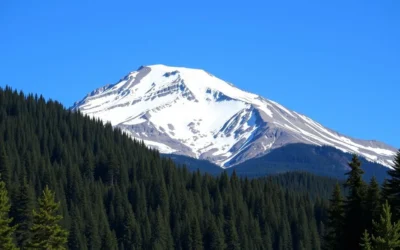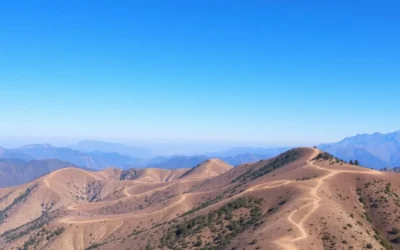Did you know Mount Lassen is one of only two volcanoes in the contiguous United States to erupt in the 20th century, with its last eruption occurring in 1921? This fascinating geological wonder, towering at 3,187 m (10,457 ft), is the centerpiece of Lassen Volcanic National Park—a hidden gem that receives just over 500,000 visitors annually compared to Yosemite’s 4.5 million. With bubbling mud pots, crystal-clear alpine lakes, and a landscape that combines elements of both Yellowstone and Yosemite, Mount Lassen offers an extraordinary adventure for nature enthusiasts without the crowds.
Getting There & Planning Your Journey
Lassen Volcanic National Park is located in northeastern California, approximately 4 hours northeast of San Francisco and 3 hours northwest of Lake Tahoe. The park is accessible via Highway 44 (to the north) or Highway 36 (to the south).
Closest Airports
- Redding Municipal Airport (RDD) – 85 km (53 miles) from the northwest entrance
- Sacramento International Airport (SMF) – 267 km (166 miles) from the southwest entrance
- Reno-Tahoe International Airport (RNO) – 241 km (150 miles) from the southeast entrance
From these airports, renting a car is essential as there is no public transportation to the park. The drive to Lassen takes you through beautiful Northern California landscapes, making it an enjoyable part of your journey.
Ready to Start Your Lassen Adventure?
Find the best flight deals to nearby airports and start planning your volcanic adventure today!
The park has five entrance stations, with the main park road, Lassen Volcanic National Park Highway, connecting the northwest and southwest entrances. This 48 km (30-mile) scenic drive takes you through the heart of the park, passing by many of its most spectacular features.
Best Time to Visit Mount Lassen
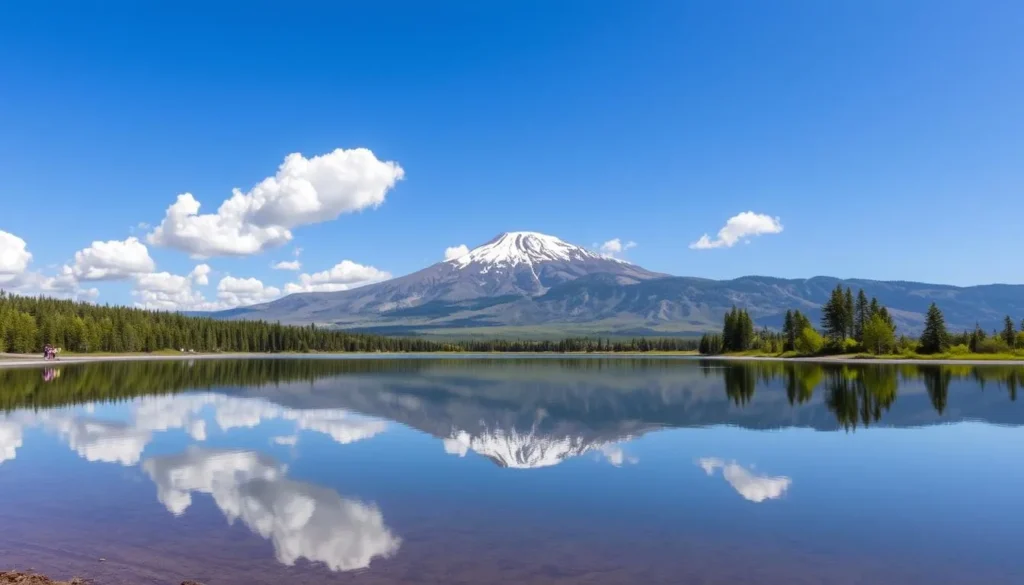
Lassen Volcanic National Park has a very narrow window for optimal visiting conditions due to its high elevation and heavy snowfall. The park receives some of the highest known winter snowfall amounts in California, which can keep roads and trails closed well into summer.
Recommended Months to Visit
- July to September – Peak season with all roads and trails typically open
- Late June – Most facilities open, though some high-elevation trails may still have snow
- Early October – Fall colors and fewer crowds, but prepare for potential early snow
Months to Avoid
- November to May – Main park road is closed due to snow; limited access to park features
- Early June – Many trails still snow-covered; Bumpass Hell and other popular trails often inaccessible
Weather at Lassen can be unpredictable even during summer months. Daytime temperatures typically range from 21°C to 27°C (70°F to 80°F), but evenings can drop to near freezing, especially at higher elevations. Always check the current conditions before your visit, as snow can affect accessibility even in summer.
Pro Tip: The third to fourth week of July is often the sweet spot for visiting Lassen—after most snow has melted but before wildfire season typically intensifies in August and September.
Getting Around Locally
Lassen Volcanic National Park spans 430 square km (166 square miles), making a vehicle essential for exploring its diverse attractions. The 48 km (30-mile) Lassen Volcanic National Park Highway is the main artery through the park, connecting the northwest and southwest entrances and providing access to many key attractions.
Transportation Options
- Personal Vehicle – The most convenient way to explore the park
- Rental Car – Available at all nearby airports and some gateway communities
- Hiking – Over 240 km (150 miles) of trails for on-foot exploration
There is no shuttle service within the park, so having your own transportation is crucial. The only gas station in the park is at the Manzanita Lake Camper Store near the northwest entrance, open 24 hours from late May through late October. Be sure to fill up before entering the park or when passing this station.
Need a Vehicle for Your Lassen Adventure?
Secure a reliable rental car to explore all of Lassen’s volcanic wonders at your own pace.
Cell phone service is limited within the park, with the best reception typically at higher elevations. Download offline maps before your visit and consider bringing a physical map, which you can purchase at visitor centers.
Where to Stay

Unlike many national parks, Lassen doesn’t have large lodges or hotels within its boundaries. Accommodation options range from campgrounds to rustic cabins, with additional lodging available in gateway communities.
In-Park Accommodations
Campgrounds
- Manzanita Lake Campground – The largest and most popular campground with 179 sites, flush toilets, and proximity to the Manzanita Lake Camper Store
- Summit Lake Campgrounds – North and South campgrounds with lake access and central location in the park
- Butte Lake Campground – More remote location with access to Cinder Cone and Butte Lake
- Warner Valley Campground – Small, primitive campground near Devil’s Kitchen and Boiling Springs Lake
Cabins
- Manzanita Lake Cabins – 20 rustic cabins (no electricity or running water) available from June through September
- Drakesbad Guest Ranch – All-inclusive historic lodge in Warner Valley with cabins, bungalows, and lodge rooms; the only place in the park with full dining service
Nearby Accommodations
- Redding – Largest nearby city (87 km/54 miles from northwest entrance) with all major hotel chains
- Chester – Small town near the southwest entrance with motels and vacation rentals
- Shingletown – Small community on the western approach with limited lodging options
Find Your Perfect Lassen Basecamp
Book your accommodations early, especially for summer visits when options fill quickly.
Reservations for in-park campgrounds and the Manzanita Lake Cabins can be made through Recreation.gov, while Drakesbad Guest Ranch bookings are managed through www.lassenlodging.com. Make reservations well in advance, especially for July and August visits.
Dining & Local Cuisine

Dining options within Lassen Volcanic National Park are limited, so planning ahead for meals is essential, especially if you have dietary restrictions or preferences.
In-Park Dining
- Lassen Cafe & Gift Shop – Located at the Kohm Yah-mah-nee Visitor Center (southwest entrance), offering soups, sandwiches, salads, and snacks. Open daily during summer (9am-5pm) with limited hours in winter.
- Manzanita Lake Camper Store – Provides grab-and-go meals, snacks, basic groceries, and ice cream. Open from June through October (8am-8pm).
- Drakesbad Guest Ranch Dining Room – The only full-service restaurant in the park, serving fresh home-cooked meals. Reservations required, even for non-guests.
Nearby Dining Options
- Chester – Several restaurants, cafes, and a grocery store
- Old Station – Limited dining options near the northwest entrance
- Redding – Full range of dining options, including Nello’s Place (Italian) and Champa Garden (Thai)
Self-Catering Tips
Many visitors bring coolers with prepared meals or ingredients for cooking at campgrounds. The Manzanita Lake Camper Store offers basic groceries, but selection is limited. For a more comprehensive grocery shop, visit Chester, Shingletown, or Redding before entering the park.
Local Tip: Pack a picnic lunch to enjoy at one of the many scenic spots throughout the park, such as Manzanita Lake, Summit Lake, or Lake Helen. Picnic areas with tables are available at several locations.
Attractions, Sightseeing & Activities
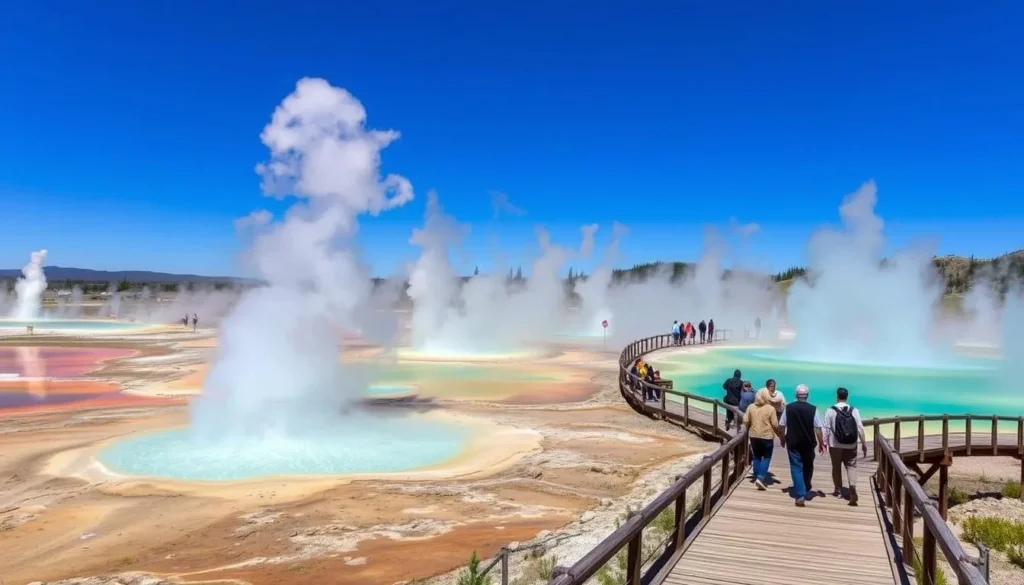
Lassen Volcanic National Park is a geological wonderland, showcasing all four types of volcanoes found in the world: shield, composite, cinder cone, and plug dome. The park’s diverse attractions range from bubbling hydrothermal areas to pristine alpine lakes and challenging hiking trails.
Must-See Volcanic Features
Bumpass Hell
The park’s largest hydrothermal area, accessible via a 4.8 km (3-mile) round-trip trail. Named after Kendall Bumpass, who severely burned his leg after falling into a boiling pool. The boardwalk trail takes you past steaming fumaroles, bubbling mud pots, and boiling springs with vibrant colors created by minerals and heat-loving algae.
Sulphur Works
The most accessible hydrothermal area, located right along the park highway. This area features bubbling mud pots and steam vents, believed to be the center of an ancient volcano called Mount Tehama or Brokeoff Volcano.
Devastated Area
An easy 0.3 km (0.2-mile) interpretive trail showcasing the destruction from Lassen Peak’s 1915 eruption. Large boulders ejected during the eruption are scattered throughout this once-forested area.
Cinder Cone
A perfectly formed cinder cone volcano with a trail to the summit (6.4 km/4 miles round-trip). From the top, you can see the colorful Painted Dunes, Fantastic Lava Beds, and even descend into the crater itself.
Scenic Lakes
- Manzanita Lake – Perfect for photography, fishing, and non-motorized boating with stunning reflections of Lassen Peak
- Lake Helen – A high-elevation alpine lake with brilliant blue waters at the base of Lassen Peak
- Summit Lake – Popular for swimming and paddling with family-friendly shorelines
- Butte Lake – Remote lake with striking turquoise waters bordered by volcanic formations
Explore Lassen’s Volcanic Wonders
Discover guided tours and activities that bring Lassen’s geological marvels to life.
Historic Sites
- Loomis Museum – Historic museum featuring photographs of the 1915 eruption taken by B.F. Loomis
- Drakesbad Guest Ranch – Historic ranch dating back to the 1900s, named for Edward Drake who believed the thermal waters had healing properties
Hiking Trails & Outdoor Adventures
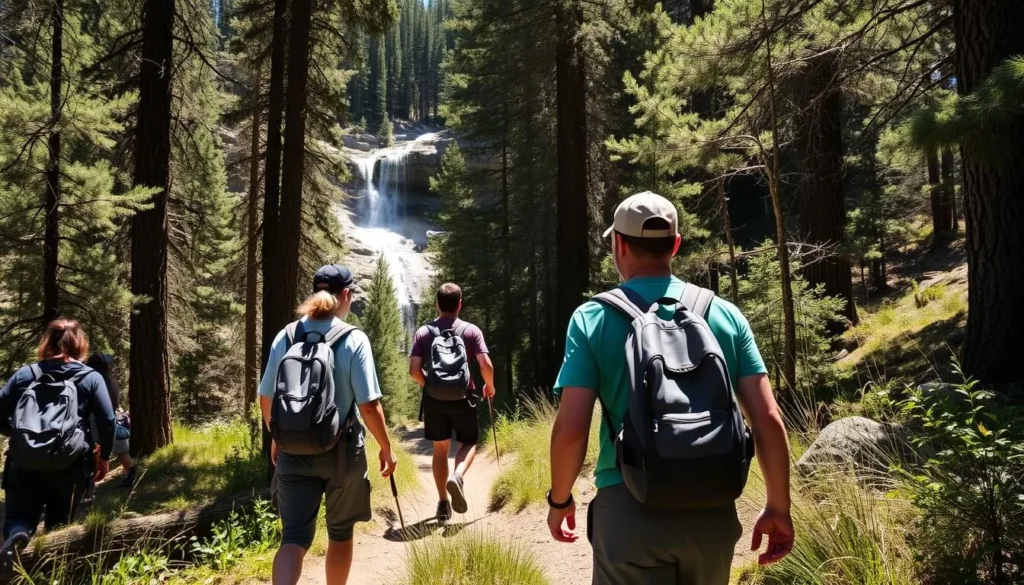
With over 240 km (150 miles) of trails, Lassen offers hiking experiences for all skill levels, from easy interpretive walks to challenging summit climbs.
Family-Friendly Trails
- Manzanita Lake Loop – 2.7 km (1.7 miles), flat trail around the lake with spectacular views of Lassen Peak
- Devastated Area Interpretive Trail – 0.3 km (0.2 miles), paved loop with interpretive signs about the 1915 eruption
- Lily Pond Nature Trail – 0.8 km (0.5 miles), easy walk around Reflection Lake and a lily pond
- Hat Lake to Paradise Meadows – 4.5 km (2.8 miles), moderate trail through wildflower-filled meadows
Moderate Hikes
- Bumpass Hell Trail – 4.8 km (3 miles) round-trip to the park’s largest hydrothermal area
- Kings Creek Falls – 4.8 km (3 miles) round-trip to a beautiful 12 m (40 ft) waterfall
- Terrace, Shadow & Cliff Lakes – 6.1 km (3.8 miles) round-trip past three alpine lakes
- Boiling Springs Lake – 4.5 km (2.8 miles) round-trip to a steaming, mineral-rich lake
Challenging Hikes
- Lassen Peak – 8 km (5 miles) round-trip with 600 m (2,000 ft) elevation gain to the summit at 3,187 m (10,457 ft)
- Brokeoff Mountain – 11.9 km (7.4 miles) round-trip with 786 m (2,580 ft) elevation gain
- Cinder Cone – 6.4 km (4 miles) round-trip with challenging sandy ascent to the summit
Water Activities
Several lakes in the park offer opportunities for swimming, fishing, and non-motorized boating:
- Kayaking & Canoeing – Rentals available at Manzanita Lake (summer only)
- Fishing – Manzanita Lake is catch-and-release only with barbless hooks; fishing also permitted at Butte Lake and Summit Lake
- Swimming – Summit Lake and Butte Lake offer the warmest waters for swimming
Hiking Tip: Always carry plenty of water, sun protection, and layers when hiking in Lassen. Weather can change quickly, and many trails have limited shade. Trekking poles are particularly helpful on steep trails like Cinder Cone and Lassen Peak.
Museums, Cultural Spots & Festivals

While Lassen Volcanic National Park is primarily known for its natural wonders, there are several cultural and educational opportunities to enhance your visit.
Museums & Visitor Centers
Kohm Yah-mah-nee Visitor Center
Located at the southwest entrance, this LEED-certified building offers interactive exhibits about the park’s geology, ecology, and cultural history. The name comes from the Mountain Maidu phrase for Lassen Peak, meaning “snow mountain.” Open year-round with longer hours during summer.
Loomis Museum
Located at the northwest entrance near Manzanita Lake, this historic museum houses photographs of Lassen Peak’s 1915-1917 eruptions taken by Benjamin Franklin Loomis. The museum also features a collection of Native American baskets and artifacts. Open summer months only.
Cultural History
The Lassen area has been home to four Native American tribes: the Atsugewi, Yana, Yahi, and Mountain Maidu. Their presence in the region dates back thousands of years, with the volcanic landscape playing an important role in their cultural traditions and daily life.
Annual Events & Programs
- Dark Sky Festival – Typically held in August, this event celebrates Lassen’s exceptional night skies with astronomy programs, telescope viewings, and presentations
- Ranger-Led Programs – During summer months, rangers offer guided walks, talks, and evening programs at campground amphitheaters
- Junior Ranger Program – Educational program for children ages 5-12, with activity booklets available at visitor centers
- Art in the Park – Occasional plein air painting workshops and art exhibitions celebrating Lassen’s landscapes
For current program schedules, check the park newspaper available at entrance stations or visitor centers, or visit the park’s official website.
Sports, Nature & Outdoor Experiences

Lassen Volcanic National Park offers year-round outdoor experiences, with each season bringing unique opportunities to connect with nature.
Summer Activities (June-September)
- Hiking – Peak season for accessing all trails, including high-elevation routes
- Wildlife Viewing – Look for black bears, mule deer, pika, and various bird species
- Wildflower Viewing – Peak blooms in meadows from late June through July
- Stargazing – Lassen’s dark skies offer exceptional views of the Milky Way and stars
- Photography – Capture reflections of Lassen Peak in Manzanita Lake at sunrise or sunset
Fall Activities (October-November)
- Fall Colors – Aspen groves display golden colors, particularly in Warner Valley
- Fewer Crowds – Enjoy popular trails with more solitude
- Wildlife Activity – Animals become more active preparing for winter
Winter Activities (December-April)
- Snowshoeing – Ranger-led snowshoe walks offered on weekends from the southwest entrance
- Cross-Country Skiing – Popular routes include Manzanita Lake area and Main Park Road
- Sledding – The Southwest Area has a designated sledding hill when conditions permit
- Winter Photography – Capture snow-covered volcanic landscapes
Spring Activities (May-June)
- Early Season Hiking – Lower elevation trails begin to open
- Waterfall Viewing – Snowmelt creates powerful flows at Kings Creek Falls and Mill Creek Falls
- Bird Watching – Spring migration brings many species through the park
Unique Experiences
- Hydrothermal Area Exploration – Witness the park’s volcanic activity at Bumpass Hell, Sulphur Works, and Boiling Springs Lake
- Parkcaching – A GPS-based scavenger hunt throughout the park (brochures available at visitor centers)
- Horseback Riding – Available at Drakesbad Guest Ranch in Warner Valley
Experience Lassen’s Natural Wonders
Book guided outdoor adventures to make the most of your visit to this volcanic paradise.
Safety, Etiquette & Local Customs
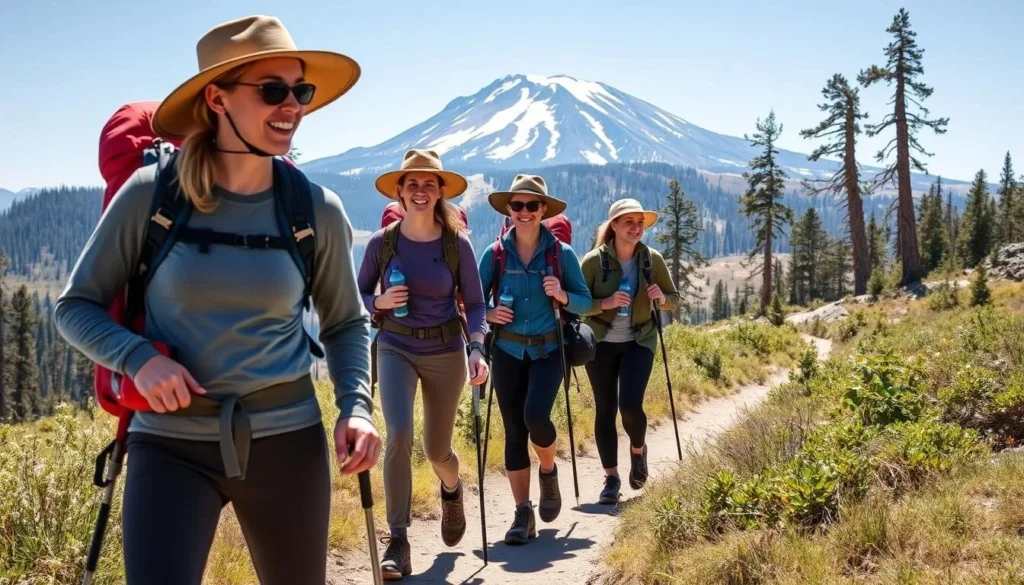
Visiting Lassen Volcanic National Park requires preparation and awareness of potential hazards. Following safety guidelines and park etiquette ensures a positive experience for all visitors while protecting this unique environment.
Safety Considerations
Hydrothermal Area Safety
- Stay on established boardwalks and trails in hydrothermal areas
- Never touch or taste water in hydrothermal areas (extremely hot and acidic)
- Be aware of steam vents that can cause burns
- Keep children close and pets away from these areas
High Elevation Precautions
- Most of the park is above 1,800 m (6,000 ft), with Lassen Peak at 3,187 m (10,457 ft)
- Acclimate gradually to prevent altitude sickness
- Symptoms include headache, nausea, dizziness, and shortness of breath
- UV exposure is stronger at high elevations; use sun protection
Weather Safety
- Weather can change rapidly; bring layers even in summer
- Afternoon thunderstorms are common in summer
- Snow can occur any month of the year at higher elevations
- Check weather forecasts before heading out on trails
Park Etiquette
Leave No Trace Principles
- Pack out all trash, including food scraps
- Stay on established trails to protect fragile vegetation
- Observe wildlife from a distance; never feed animals
- Respect quiet hours in campgrounds (typically 10pm-6am)
Wildlife Etiquette
- Keep at least 30 m (100 ft) from deer and 90 m (300 ft) from bears
- Store food properly in bear-resistant containers or lockers
- Never approach or feed wildlife
Important Safety Note: Cell phone service is extremely limited throughout the park. Download offline maps, inform someone of your plans, and consider carrying a satellite communication device for emergencies when hiking in remote areas.
Visitor Comments About Mount Lassen
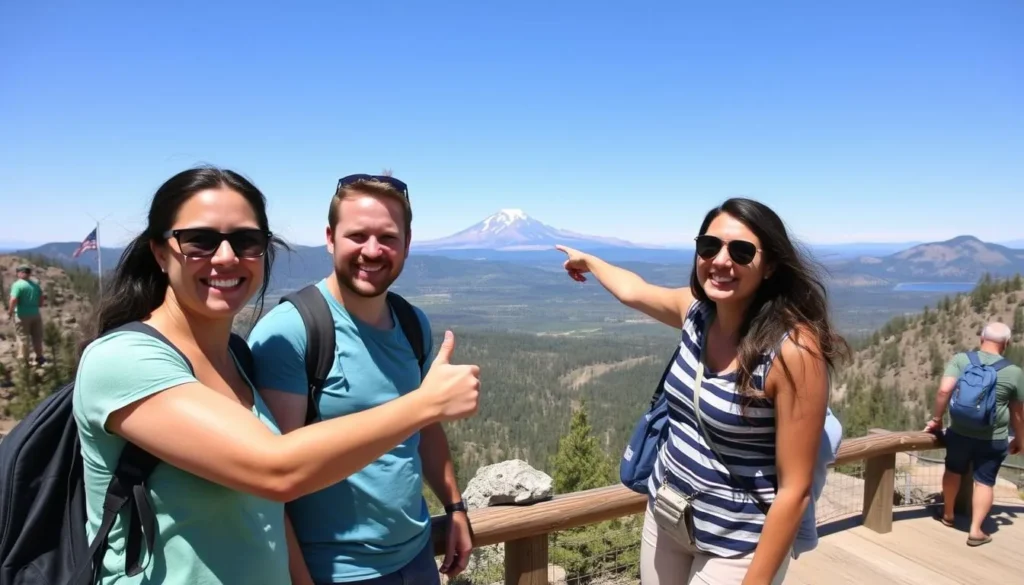
“We visited Lassen in July and were blown away by how uncrowded it was compared to other national parks. The hike to Bumpass Hell was fascinating—like walking on another planet with all the steam vents and bubbling mud pots. Don’t miss the sunset at Manzanita Lake for perfect reflections of Lassen Peak. This hidden gem deserves more recognition!”
“Our family tackled the Cinder Cone hike, which was challenging but absolutely worth it. The view from the top of the Painted Dunes and surrounding landscape was unforgettable. My kids still talk about walking inside a volcano’s crater! We stayed at Manzanita Lake Campground, which was perfect for families with clean facilities and a beautiful lake just steps away.”
“I’ve visited Lassen three times now—summer, fall, and winter—and each season offers something special. Winter was particularly magical with snowshoeing through silent forests and having hydrothermal areas like Sulphur Works almost entirely to ourselves. The steam is even more dramatic against the snowy landscape. Just be prepared for limited access as most of the park road is closed.”
Practical Travel Tips

What to Pack
- Layered Clothing – Even summer days can start cold and end hot; nights are always cool
- Sun Protection – Hat, sunglasses, and sunscreen (UV exposure is stronger at high elevations)
- Hiking Boots – Many trails have loose volcanic rock and uneven terrain
- Water Bottles – Hydration is crucial at high elevations; limited water sources on trails
- Insect Repellent – Mosquitoes can be prevalent near lakes and in meadows
- Headlamp/Flashlight – Essential for night sky viewing and early morning starts
- Binoculars – For wildlife viewing and distant volcanic features
Park Fees & Passes
- Vehicle entrance fee: $30 (valid for 7 days)
- Annual Lassen Volcanic National Park Pass: $55
- America the Beautiful Pass (all national parks): $80 annually
- Free entrance days offered several times throughout the year
Planning Resources
- Official Park Website: www.nps.gov/lavo
- Road Status: Current Conditions
- Trail Status: Hiking Trails
- Campground Reservations: Recreation.gov
Pro Tip: Free WiFi is only available at the Kohm Yah-mah-nee Visitor Center. Download offline maps, trail guides, and any necessary information before entering the park, as cell service is limited throughout.
Nearby Attractions
If you have extra time, consider visiting these attractions near Lassen:
- Burney Falls – Spectacular 39 m (129 ft) waterfall in McArthur-Burney Falls Memorial State Park, about 1 hour north of Lassen
- Subway Cave – Lava tube cave near the northwest entrance, offering a cool underground exploration
- Lake Almanor – Large recreational lake with boating, fishing, and swimming, about 30 minutes from the southwest entrance
Your Lassen Adventure Awaits: Nature’s Volcanic Wonderland
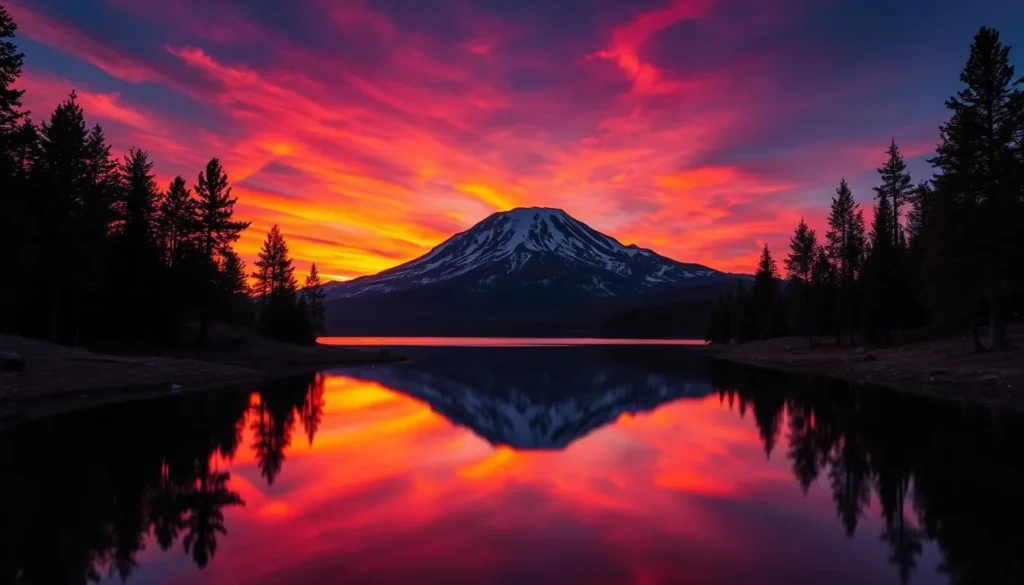
Mount Lassen offers a rare opportunity to experience a volcanic landscape without the crowds that flock to more famous national parks. From bubbling mud pots and steaming fumaroles to crystal-clear alpine lakes and challenging summit hikes, this hidden gem of the National Park System delivers experiences that will stay with you long after you’ve returned home.
Whether you’re watching the sunset paint Lassen Peak in golden hues from the shores of Manzanita Lake, feeling the earth’s heat rising from Bumpass Hell, or standing triumphantly atop Cinder Cone with the Painted Dunes spread below, Lassen creates moments of wonder and connection with our planet’s powerful geological forces.
As one of America’s least-visited national parks, Lassen provides the increasingly rare gift of solitude in nature. Here, you can still find trails where you might be the only hiker, viewpoints where the only sound is the wind, and night skies dark enough to make the Milky Way pop with clarity. Plan your visit to this extraordinary volcanic wonderland and discover why those who know Lassen count it among California’s most special places.
The above is subject to change.
Check back often to TRAVEL.COM for the latest travel tips and deals.

